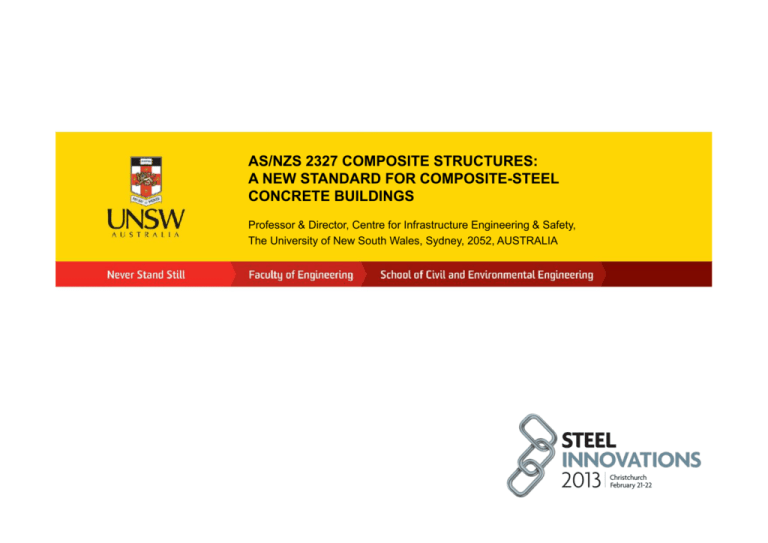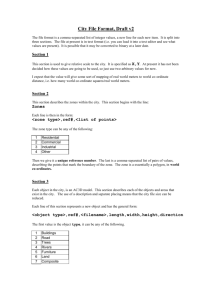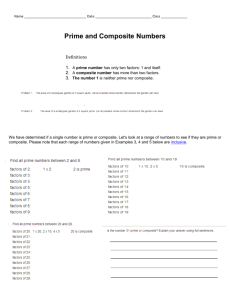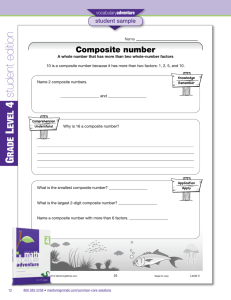as/nzs 2327 composite structures: a new standard for composite
advertisement

AS/NZS 2327 COMPOSITE STRUCTURES: A NEW STANDARD FOR COMPOSITE-STEEL CONCRETE BUILDINGS Professor & Director, Centre for Infrastructure Engineering & Safety, The University of New South Wales, Sydney, 2052, AUSTRALIA Abstract This paper will outline the background behind the proposed joint Australian/New Zealand standard for composite steel-concrete buildings. The standard has commenced drafting and currently has three sub-committees working on composite slabs, composite beams and composite columns. The standard will be developed as a single document which builds on the historical AS2327.1-2003 standard for the design of simply supported composite beams as well as other Australian, New Zealand and international antecedent standards in the steel and composite structures area. It is envisaged that this standard will consider continuous composite beam design, include provisions for the design of composite slabs and also incorporate design rules for the shear connection of composite beams with precast and hollow core planks. The design approach for composite columns builds on the approach in the current AS/NZS AS5100 Part 6 for bridge structures and will incorporate important design provisions specific to multi-storey building design. It is also envisaged that system approaches for serviceability and fire design of composite floors will be encompassed in the new standard. It is expected that the standard will be published in 2014. Introduction Recent significant activity on the joint development of an Australian Standard for Bridge Structures in Steel and Composite Structures has highlighted the need and galvanized the industry to develop a harmonised standard for steel-concrete composite structures for buildings. This project is titled “Suite of Standards for Composite Structures for use in Buildings and other non bridge infrastructure incorporating existing AS2327.1-2003, AS2327.2201X, AS2327.3-201X and ASS2327.4-201X” which received approval in November 2011 and commenced drafting in July 2012 and will be due for completion by July 2014. The project is now referred to as the AS/NZS 2327, Composite Structures and will be a single document. Introduction Composite structures using steel-concrete composite construction techniques generally tend to be the preferred method of construction for steel framed buildings in Australia, New Zealand and most developed countries. Composite construction tends to reduce the amount of structural steel being used and thus lends itself to greater sustainability benefits than other methods of construction. Furthermore, composite construction also provides steel-frames with the robustness of concrete frames by possessing the added advantages of light-weight which has many other potential benefits for the construction process. The NSW Government Offices completed in 1965 and demolished in 1997 were Australia’s tallest skyscraper on completion reaching 38 levels. This building relied on innovative methods of construction to achieve speed of construction and employed many composite construction methods, namely composite beams spanning 10 metres, composite slabs utilising metal decking. Furthermore, this building involved the first major use of composite construction in columns, namely encased sections. Composite steel-concrete structures involving concrete and steel components following the period of significant multi-storey building activity in Australia were able to be designed using a combination of the Australian Standard for Concrete Structures, AS1480-1974, (Standards Australia 1974a) and the Australian Standard for Steel Structures, AS1250-1975, (Standards Australia, 1975). Both of these standards were based on working stress principles. The limitations on the concrete compressive strength in AS 1480-1974 ranged from 15-50 MPa (N/mm2). The limitations on the tensile strength of the steel reinforcement able to be used in AS1480-1974 ranged from 230-410 MPa (N/mm2). The maximum steel yield stress able to be used in AS1250-1975 was 450 MPa (N/mm2). In addition to these two standards a supplement for composite steel-concrete construction in buildings of AS1480-1974 was also produced, (Standards Australia, 1974b). Composite steel-concrete beams following this period were able to be designed using the Australian Standard, AS 2327.1-1980, (Standards Australia, 1980). This standard adopted a working stress design procedure limiting the concrete stress in compression and the steel stress in tension and thus pertained to simply supported beam construction only. In addition to strength criteria for flexure, serviceability criteria including deflections and vibrations were also covered by this standard. Limit states versions of this were then produced in 1996 and 2003 respectively, (Standards Australia 1996 and 2003). Thus, currently in Australia, the design of composite structures for buildings is covered in a piecemeal fashion by three standards AS2327.1-2003, AS3600-2009 and AS4100-2012 (Standards Australia 2003, 2009 and 2012) and in New Zealand by NZS 3404, (Standards New Zealand, 2009). The development of AS/NZS 2327 will improve harmonisation, will allow innovative aspects of composite construction and design to be incorporated in one standard and will also allow state of the art international research to be incorporated into a single document. Superseded Standards Superseded Standards Composite steelconcrete beams, 1996 & 2003 Composite steel-concrete beams were able to be designed using a limit states design format through the introduction of AS2327.1-1996, and AS2327.1-2003. These standards only covered the design of simply supported composite beams. The steel yield stress was limited to a maximum of 450 MPa (N/mm2) and the concrete compressive strength was limited to a value of 40 MPa (N/mm2). Composite steel-concrete columns (Concrete structures, 1994, 2001 and 2009) Composite steel-concrete structures for buildings were able to be designed using the Australian Standard for Concrete Structures AS3600. This standard had three versions during this period, AS3600-1994, AS3600-2001, and AS36000-2009. The major changes in these versions were the gradual increase in concrete compressive strengths from 50, to 65 and now 100 MPa (N/mm2). The steel reinforcing yield strengths have also gradually increased up to 500 MPa (N/mm2) in the most recent version. Composite steel-concrete structures (Steel structures, 1998 and 2012) The standard for steel structures AS4100 also had two versions during this period, AS41001998 and AS4100 Ammendment 1 – 2012. The major change introduced with the new amendment was the introduction of high strength steel up to 690 MPa (N/mm2). Proposed Structure This section will highlight some of the salient aspects that are proposed to be included in the standard. This is not meant to be the exact table of contents, rather an indication of the main sections that will be covered in the standard. Initially it was proposed to develop four separate standards on beams (simplysupported and continuous), columns and slabs. However, based on the advice of the Australian Building Codes Board the committee has decided a single document to be referred to as AS/NZS 2327 Composite Structures will be developed. The initial proposed layout with notation to describe the various sections is given below AS/NZS 2327: COMPOSITE STRUCTURES SECTION 1 COMPOSITE CONSTRUCTION 1.1 Scope and General 1.2 Materials [Important strength changes in AS3600 & AS4100 will be reflected] 1.3 General Design Requirements 1.4 Actions and Design Situations 1.5 Methods of Structural Analysis SECTION 2 DESIGN OF COMPOSITE SLABS 2.1 ......etc [This section will cover the strength and ductility design for simply supported and continuous composite slabs with profiled steel sheeting. It will draw heavily on overseas standards such as AISC and Eurocode and any new research that is mature for incorporation.] SECTION 3 DESIGN OF COMPOSITE BEAMS 3.1 ......etc [This section will cover the strength and ductility design for simply supported and continuous composite beams with solid slabs, composite slabs and precast planks. It will draw heavily on AS2327.1-2003, One Steel Design Manual on Continuous Composite Beams, overseas standards such as AISC and Eurocode and any new research that is mature for incorporation.] SECTION 4 DESIGN OF COMPOSITE COLUMNS 4.1 ......etc [This section will cover the strength and stability design of composite columns; it will draw heavily on AS5100: Part 6, overseas standards such as AISC and Eurocode and any new research that is mature for incorporation] SECTION 5 DESIGN FOR SERVICEABILITY 5.1 ......etc [This section will cover the serviceability design of composite slabs and beams. It will draw heavily on AS2327.1-2003, overseas standards such as AISC and Eurocode and any new research that is mature for incorporation. Methods to identify system behaviour for deflections and vibrations of beams and slabs will be incorporated herein. Guidance on column shortening for tall buildings will also be provided] SECTION 6 DESIGN FOR FIRE RESISTANCE 6.1 ......etc [This section will cover the fire resistance design of composite slabs and beams. It will draw heavily on AS2327.1-2003, overseas standards such as AISC and Eurocode and any new research that is mature for incorporation. Methods to identify system behaviour for fire resistance of beams and slabs will be incorporated herein. Guidance on composite columns in fires will also be provided.] SECTION 7 TESTING METHODS 7.1 ......etc [This section will cover the testing methods used for strength and ductility behaviour of composite slabs and shear connectors in composite beams. General testing methods and guidance on sampling methods will also be provided.] Composite Construction The proposed Section 1 of AS/NZS currently contains seven sub-sections, including Scope and General; Materials; General Design Requirements; Actions and Design Effects; and Methods of Structural Analysis. Scope and General This section highlights the intent of the standard in terms of what types of structural forms are covered. Thus structural steel section types, shear connector types, profiled steel sheeting types are all discussed in this section. This is also where definitions and notation for the standard will be specified. Issues associated with construction and erections are also proposed to be covered in this section. Materials This section outlines the various material and the relevant Australian/New Zealand materials standards that need to be adhered to in specifying materials. Materials for structural steel; bolts, nuts and washers; welds and welding; shear connectors; profiled steel sheeting; concrete and reinforcement are all outlined in this section. General Design Requirements This section outlines the general design requirements; including various limits states and their respective capacity factors. Issues relating to durability, fire resistance and prototype testing are also outlined herein. Actions and Design Effects This section describes the typical actions and design effects that need to be considered. Issues associated with erection and construction. Also, in service issues associated with temperature as well as creep and shrinkage are described in this section. Methods of Structural Analysis This section will provide some guidance on methods of structural analysis and will draw on the various approaches in the Australian Concrete and Steel Standards (Standards Australia, 2009 and 2012). Furthermore, higher level analyses such as finite element analysis will be introduced in a similar fashion to that being proposed for the new AS/NZS 5100: Part 6, Steel and composite structures. Design of Composite Slabs The intent of this section is to cover the strength and serviceability design of composite slabs utilising metal decking. Issues including flexural strength, longitudinal shear and vertical shear provisions will be covered in this section. Concepts of partial interaction will also be considered and this section will also link quite closely to that being proposed for testing. Other issues that are also being proposed to be covered include the issues associated with the design of slabs using precast panels and topping slabs. Furthermore, post-tensioned concrete construction is also extremely prominent in Australian buildings and recent innovations into post-tensioning concrete slabs with metal decking have been carried out. One of the major issues is the changes that need to be introduced to deal with the presence of the metal decking for serviceability and strength provisions and these will be considered as part of this section. Design of Composite Beams This section will cover the design of composite beams, considering flexural strength, shear strength and combined actions as well as serviceability provisions. Partial shear connection approaches will also be a highlight for the design of simply supported and continuous beams. Typical types of composite beam types as illustrated in Figure 4 will be considered. It is also anticipated to cover the design of composite beams using hollow core slabs as outlined in Figure 5. Composite Beam Types Hollowcore planks Large web openings Composite beams Recent research into the behaviour and design of steelconcrete composite beams under combined actions has been carried out. Combined actions of flexure and torsion, flexure and axial force and flexure and shear have been investigated to address current deficiencies in international standards. Many practical situations require these combinations to be addressed and future research and design recommendations are expected to be incorporated in future Australian Standards. Flexure & shear Ongoing research is being carried out to quantify the effects of the presence of the concrete slab and it’s role in the resistance of vertical shear in a composite steel-concrete beam. Flexure & torsion Ongoing research is being carried out to quantify the effects of the presence of the concrete slab and it’s role in the resistance of torque in a composite steel-concrete beam. Interaction of flexure and axial force Interaction of flexure and axial force Interaction of flexure and axial force Comparison between the interaction diagrams by CSA and RPA Flexure & axial force Ongoing research is being carried out to quantify the effects of the presence of the concrete slab and it’s role in the resistance of axial force in a composite steel-concrete beam. Recently completed tests Design of Composite Columns This section is proposed to cover the design of composite columns and will closely follow the approach in the AS/NZS 5100 Part 6 (Standards Australia, 2004). The design of composite columns for strength, stability incorporating axial force, uniaxial and biaxial bending will be considered. Composite sections as illustrated in Figures 6 and 7 will be covered in this section. In particular the important effects of confinement are covered by this section. One major area of innovation which this section will cover includes the use of high strength concrete (cylinder strengths up to 100 MPa) and high strength steel (nominal yield strengths up to 690 MPa). There is currently ongoing work to establish appropriate capacity factors to allow the incorporation of these higher strength materials, (Kang et al. 2012). Composite Columns Slenderness limits: box sections b fy ≤ 50 t 250 σol be =α b fy Slenderness limits: tube sections d fy ≤ 125 t 250 Compressive Strength Calibration results (a) compact sections (b) not-compact sections (c) non-compact sections For the target reliability β = 3.04 suggested in AS 5104: 2005/ISO 2394 (1998), the calibration results are equally Ԅ = 0.94. This implies that the suggested values in AS 4100 and AS 5100, i.e., Ԅ = 0.90 is on the conservative side. Column Curves Design for Serviceability The intent of this section is to address system behaviour particularly for deflections and vibrations for panels. This will then give designers the ability to take into account the beneficial effects of system behaviour in addressing these important serviceability provisions which sometimes penalize steel frames structures from a design perspective, (Steel Construction Institute, 2009). Design for Fire This section is also intended to give guidance on design for fire using a system based approach, which acknowledges that for indeterminate systems there is a significant degree of redundancy that provides additional structural capacity within a fire that is unable to be addressed considering single elements within a building. State of the art approaches for dealing with this will be provided herein, (Steel Construction Institution, 2012). Testing This section of the proposed standard is meant to provide standard test methods for a number of specific issues which are covered. Push test methods for establishing the strength, stiffness and ductility of shear connectors will be outlined in this section as will test methods for establishing the strength characteristics of composite slabs incorporating profiled steel sheeting. Other Issues The previous sections have served as an introduction to the scope and structure of the proposed standard AS/NZS 2327. During the drafting process, other issues which have been raised that will inevitably be included, these relate to erection and construction methods and robustness issues. It is expected that some of these issues if felt specific to composite structural design will be included in the standard Conclusions This paper has provided some background to the basis of the project to develop a joint Australian/New Zealand standard on composite structures, namely AS/NZS 2327 Composite Structures. A brief history behind the practical uses of composite construction in buildings and the associated design standards that have enabled their wider deployment has been provided. The structure and scope of the proposed AS/NZS 2327 has been provided and innovations in the various sections have been highlighted. Some of the major introductions include the use of higher strength concrete and steel materials. Furthermore, systems approaches will also be addressed in the standard. Acknowledgements This paper has been prepared by the author and is meant to be an informative exercise to outline the scope and structure of the proposed AS/NZS 2327 Composite Structures Standard. The final standard is subject to committee decisions and the public comment phase and thus information herein is subject to change. The author would particularly like to thank the initial working group of Dr Stephen Hicks (HERA, New Zealand), Dr Peter Key (Australian Steel Institute) and Mr Anthony Ng (One Steel, Australia) for their leading role in proposing, developing and driving this project. Furthermore, the input of all the Australian and New Zealand nominating organisations has also been extremely valuable in ensuring that this project received the support in the proposal and drafting stages. We look forward to being able to communicate the progress of this project and hope for its completion in mid-late 2014. Questions ?






